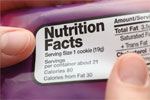Labelling laws

Health is not really a priority for most confectionery consumers, but it is covered by ingredient labelling designed to promote well being anyway – and the industry has to take note. The European Union (EU) is a case in point: it has been updating legislation on food labelling to promote consumer awareness about not-so-healthy ingredients in food products. However, while confectionery can be regarded as inherently ‘unhealthy’, manufacturers do not seem worried about new mandatory EU nutrition labelling legislation having a negative impact on the sales of sweets and bakery items.
Nutrition declaration
One key issue for EU manufacturers are new provisions within the EU’s food information to consumers (FIC) regulation (1169/2011) mandated that by the end of a five-year implementation phase (starting December 2011), all pre-packaged food must be labelled with a nutrition declaration consisting of energy, saturated fat, carbohydrates, protein, saturates, sugar and salt quantities. The regulation calls for energy values and amounts of nutrients to be expressed per 100g/100ml – or per portion where appropriate – and requires labelling to be clear and legible: establishing a minimum font size for the mandatory information of 1.2mm, and 0.9mm for products whose packaging has a largest surface of less than 80cm2.
Although it may seem counterintuitive to mandate products with inherently high fat and sugar contents to displaying those properties prominently on packaging, Ildiko Szalai, packaged foods industry analyst at Euromonitor says that she cannot imagine this legislation harming the confectionery sector.
“Confectionery is confectionery – I don’t think that anyone goes to the shop looking for something healthy and then purchases confectionery,” she said, “Generally speaking, [confectionery] will actually be one of the industries affected the least by this legislation.”
Laurence Vicca, spokesperson for Caobisco, the association of chocolate, biscuit and confectionery industries of the European Union agrees, “Caobisco products are mostly indulgent products…all of them can be part of a balanced diet if eaten in moderation,” she says.
Szalai added it would in any case be difficult to predict whether this legislation will reduce confectionery sales long term, because of the current fragile economy, “Companies are still recovering from the recession, and there are many other factors – you cannot isolate the impact of one [piece of] legislation.”
Ingredient scarcity
According to the Association of the German Confectionery Industry (BDSI), sales of confectionery actually might slow this year – but not because of nutrition labelling, because of ingredient scarcity and cost – especially sugar. Now, in 2012, “manufacturers’ biggest concerns continue to be the availability of sufficient amounts of certain raw materials and the large increases in raw material prices,” believes a BDSI spokesperson.
But health concerns can never help. Data from London based market research firm Mintel released in December 2011 on the sugar and gum confectionery market in Europe revealed that in the ‘Big 5’ European countries (Germany, France, Italy, Spain and Britain), sales of sugar and gum confectionery have remained stagnant over past four years (2008-2011), showing barely any growth from €8.6 billion in 2008 to an estimated €8.9bn in 2011.
According to Mintel, these static sales are largely due to consumer concerns surrounding health issues such as obesity, in addition to difficulties surrounding global confectionery prices. When it comes to the latest trends in confectionery, according to Mintel, the most noticeable one is the introduction of more natural ranges, and the elimination or reduction of additives and preservatives – which will help manufacturers exploit the new labelling rules in a positive way.
Marketing strategies
Szalai stressed manufacturers have been developing different marketing strategies inspired by wellness demand trends. For example, she said, companies in recent years have been introducing smaller pack sizes, along with bite sized and more portion controlled products. Mars for example, recently announced that king size versions of its Mars and Snickers bars would be disappearing from shelves, with the company planning to stop producing chocolate products that exceed 250 calories, by the end of next year.
To increase margins, many confectioners have also integrated ‘value added qualities’ into their products, added Szalai, such as fair trade or organic properties. In the UK of course, Cadbury has been switching sourcing to Ghanaian fair trade cocoa, while France’s Alter Eco company re-launched its Noir Intense dark chocolate tablets with organic and fair-trade certifications plus a carbon neutral stamp. This past January, Barry Callebaut launched Cameroon chocolates and cocoa powders made with cocoa from a sustainable cultivation. These value added qualities can often be a better selling point than ‘low-fat’ or ‘low-sugar’, said Szalai.
Still, some confectionery manufacturers such as Barry Callebaut are also incorporating ingredients with nutritional value in their products. For example, the company recently publicised a scientific study about how chocolate can be good for the brain if it contains high amounts of cocoa flavanols – such as is found in Barry Callebaut products.
“Within the context of increasing rates of obesity and other diet-related non-communicable diseases, many confectionery manufacturers are indeed investing resources to improve the nutrition composition of their products, for example by reducing and/or replacing sugar or by replacing saturated fat with healthier fats – polyunsaturated, monounsaturated, etc,” says Miguel da Silva, global director of health and nutrition policy at EAS, a Brussels based leading advisory company specialising in European and international regulation on food and nutritional products.
Reformulation has certain limitations, however, said Caobisco’s Vicca, since ingredients such as fats and sugar play key sensorial (colour, taste and texture) and technological roles in products, and cannot always be reduced or substituted without altering the product itself. In addition to this, changes to formulations are also only possible within the parameters set by existing statutory provisions. For example, in the case of chocolate, statutory provisions in the EU chocolate directive and technological factors allow no significant changes to formulations. “It is often a challenge to change a product’s ingredients while maintaining the taste that consumers have come to love and expect,” adds Vicca.
Who will be affected by legislation changes?
And while confectionery manufacturers have five years to incorporate the mandatory nutrition labelling onto packaging, da Silva said that legislation will not stretch companies who already providing nutrition labelling on their products. “The new provisions will not really be an issue for those confectionery manufacturers that already provide nutrition information on a voluntary basis. It is mostly smaller manufacturers (SMEs), which may not be doing it voluntarily today that will need to do it in the future,” he says.
Indeed, in 2005 Nestlé introduced its Nutritional Compass on all its products: an on-pack information panel providing consumers with relevant, easy-to-understand nutrition information.
That said, da Silva stressed that one concern cropping up in the industry in regards to the new legislation has to do with the provision introducing a mandatory minimum font size.
“This is generally an issue in Europe due to the fact that a considerable number of food products are sold across different Member States and include multi-lingual labels,” says da Silva. “This is an even bigger issue for confectionery manufacturers, as a considerable number of products are sold in very small packs.” Chewing gums and mints, for example, will have serious difficulties complying with the required mandatory minimum font size; particularly in markets where products must be labelled in more than one national language. “It is not clear yet how companies will cope with this requirement, other than by increasing the package size,” says da Silva, adding that with this, the new rules might lead to additional costs.
Ever changing requirements in terms of food labelling can be a real burden, adds Vicca – in particular for SMEs, and in terms of innovation. “[The confectionery industry] invests a lot of time and resources to bring their products in line with consumer taste and public health expectations over the years – improved labelling, reformulation, portion sizes, etc. – and this is often a challenge,” she concludes.
By MJ Deschamps



